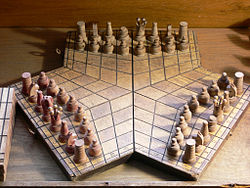Three-player variants
Boards with hexagonal cells

Some variants use a board with hexagonal cells. Usually three bishops per side are included, to cover all cells of the hex playing field. Pieces move usually as in one of the versions of hexagonal chess.
- Chesh: [3] Played on a 169-cell regular hexagon board. By Douglas Hofstadter (2005); interpreted by Gianluca Moro.
- Chexs: [4] By Stephen P. Kennedy. Multi-player variant for up to six.
- Echexs: [5] By Jean-Louis Cazaux. Multi-player variant for up to six.
- HEXChess: [6] Commercial chess variant by HEXchess Inc.
- Three-Handed Hexagonal Chess, [7] more commonly known as Wellisch's Hexagonal Chess: [8] Published by Siegmund Wellisch in 1912. It has no bishops; instead, each of the three knights move one space only in any of the six "diagonal" directions.
- Three-Way Chess: [9] Played by three players on an irregular hexagonal board of either 140 or 200 cells. By Richard Harshman. [10] In both versions, the home rows of all players are 8 cells wide. However, the smaller version has 7 cells on the three alternate sides while the larger version has 9. [11]
Boards with quadrilateral cells
Hexagonal boards


Some variants use a hexagonal-shaped board with quadrilateral cells (see example in the photo).
- Trichess: [12] Features a "non-aggression" rule whereby a player in inferiority is immune from capture in his home portion by a numerically superior opponent, unless the capture also gives check. A pawn that reaches the back rank of an opponent is exchanged for any previously captured friendly piece. Played on a 96-cell board. By Christophe Langronier (date unknown).
- Chess for three: [13] By Jacek Filek (1992).
- Three-Man Chess : Pawns reaching the 5th rank gain multi-direction capability. The first player to give checkmate wins. Played on a 96-cell board. By George Dekle Sr. (1984).
- Trio-Chess: [14] Played on a 96-cell board, a center triangle splits the central files. By Van der Laken and G. J. Buijtendorp (1979).
- Three-Player Chess: [15] Played on a 96-cell board, the patent for this game provides suggested rules whereby kings are captured, and the player with the last-remaining king wins. The pieces of an eliminated player remain on the board and may be captured. A player may move into check. The patent also describes a variant whereby the army of an eliminated player is appropriated by the capturer. [16] By Robert Zubrin (1971).
- Self's Three-Handed Chess: [17] Played on a 144-cell board. By Hency J. Self (1895).
- Waidder's Three-Handed Chess: [18] Played on a 126-cell board. By S. Waidder (1837).
Other boards
Some variants have used other board shapes with quadrilateral cells.
- III-Color-Schach: [19] Uses a special three-dimensional board or can be used with three-colored boards.
- Megachess: [20] Uses a roughly triangular board with 130 squares. Pawns have multi-direction capability. Players manage the first-mated player's army according to one of three options. The last surviving player wins. By Mega Games/Danny McWilliams (1986).
- Mad Threeparty Chess : Play starts on an empty 10×10 board with players placing their pieces initially, including an extra king per side. Kings are designated so that each opponent attacks a different king of a given player. By V. R. Parton (1970).
- Triple Chess: [21] Uses a chessboard unbalanced by 8×3 extensions on three sides. A player must checkmate or stalemate both opponents to win, using only pieces of his color. By Philip Marinelli (1722).
Boards with triangular cells

Triangular cells not on the perimeter have three cells obliquely adjacent, and three cells adjacent at points.
- A variant patented in 2008 by Russian Ilshat Tagiev uses a hexagonal board with triangular cells. [22] Armies are initially set up in the corners of the hexagon. Play order is clockwise around the board. All pieces move as in standard chess but adapted to the triangular boardcell geometry. Adjacent cells of the same color form the board's "diagonals"; adjacent cells of opposite color form the board's "orthogonals" (vertical and horizontal). Pawns can move in any direction on vertical or horizontal lines. (So, pawns can be directed against both opponents.) Pawns do not promote. A special "Rule of Neutrality" addresses the petty diplomacy problem while maintaining the possibility of cooperation: The player whose turn it is to move, can capture an enemy man only if the third player did not capture a man of that enemy on the previous move, or if that enemy captured a man of the player (thus, the possibility of concerted serial attacks by two players against a third is ruled out). [23] [24]
Circular boards
Circular boards have three- or four-sided cells, but not triangular or quadrilateral.
Using fairy pieces
Some variants incorporate fairy chess pieces in addition to standard chess pieces.
- Orwell Chess: [27] Uses a cylindrical board with quadrilateral cells. Armies consist of fairy pieces gryphon, dabbabah, pao, raja, etc. By Glenn E. Overby (2002).
- Tri-Chess : [28] A three-player variant using an irregular hexagon board with triangular cells. Chancellors and cardinals replace queens. By George Dekle Sr. (1986).